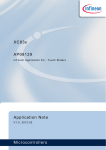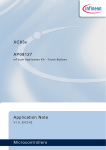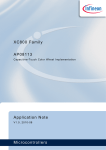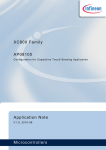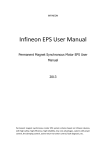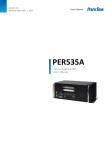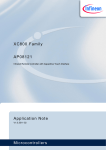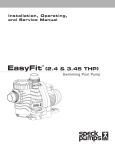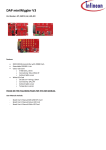Download inTouch Application Kit
Transcript
XC83x AP08126 Infineon Touch Solutions - inTouch Application Kit Application Note V1.0, 2012-02 Microcontrollers Edition 2012-02 Published by Infineon Technologies AG 81726 Munich, Germany © 2012 Infineon Technologies AG All Rights Reserved. LEGAL DISCLAIMER THE INFORMATION GIVEN IN THIS APPLICATION NOTE IS GIVEN AS A HINT FOR THE IMPLEMENTATION OF THE INFINEON TECHNOLOGIES COMPONENT ONLY AND SHALL NOT BE REGARDED AS ANY DESCRIPTION OR WARRANTY OF A CERTAIN FUNCTIONALITY, CONDITION OR QUALITY OF THE INFINEON TECHNOLOGIES COMPONENT. THE RECIPIENT OF THIS APPLICATION NOTE MUST VERIFY ANY FUNCTION DESCRIBED HEREIN IN THE REAL APPLICATION. INFINEON TECHNOLOGIES HEREBY DISCLAIMS ANY AND ALL WARRANTIES AND LIABILITIES OF ANY KIND (INCLUDING WITHOUT LIMITATION WARRANTIES OF NON-INFRINGEMENT OF INTELLECTUAL PROPERTY RIGHTS OF ANY THIRD PARTY) WITH RESPECT TO ANY AND ALL INFORMATION GIVEN IN THIS APPLICATION NOTE. Information For further information on technology, delivery terms and conditions and prices, please contact the nearest Infineon Technologies Office (www.infineon.com). Warnings Due to technical requirements, components may contain dangerous substances. For information on the types in question, please contact the nearest Infineon Technologies Office. Infineon Technologies components may be used in life-support devices or systems only with the express written approval of Infineon Technologies, if a failure of such components can reasonably be expected to cause the failure of that life-support device or system or to affect the safety or effectiveness of that device or system. Life support devices or systems are intended to be implanted in the human body or to support and/or maintain and sustain and/or protect human life. If they fail, it is reasonable to assume that the health of the user or other persons may be endangered. AP08126 Infineon Touch Solutions - inTouch Application Kit XC83x Revision History: V1.0 2012-02 Previous Version(s): Page Subjects (major changes since last revision) – We Listen to Your Comments Is there any information in this document that you feel is wrong, unclear or missing? Your feedback will help us to continuously improve the quality of this document. Please send your proposal (including a reference to this document) to: [email protected] Application Note 3 V1.0, 2012-02 AP08126 Infineon Touch Solutions - inTouch Application Kit Table of Contents 1 Introduction . . . . . . . . . . . . . . . . . . . . . . . . . . . . . . . . . . . . . . . . . . . . . . . . . . . . . . . . . . . . . . . . . . . . . 5 2 2.1 2.2 Hardware . . . . . . . . . . . . . . . . . . . . . . . . . . . . . . . . . . . . . . . . . . . . . . . . . . . . . . . . . . . . . . . . . . . . . . . 6 Mother Board (USB Stick) . . . . . . . . . . . . . . . . . . . . . . . . . . . . . . . . . . . . . . . . . . . . . . . . . . . . . . . . . . 6 Daughter Boards . . . . . . . . . . . . . . . . . . . . . . . . . . . . . . . . . . . . . . . . . . . . . . . . . . . . . . . . . . . . . . . . . . 7 3 3.1 3.1.1 3.1.2 3.1.2.1 3.1.2.2 3.2 3.2.1 3.2.2 3.2.3 3.2.4 Infineon’s Touch Solutions . . . . . . . . . . . . . . . . . . . . . . . . . . . . . . . . . . . . . . . . . . . . . . . . . . . . . . . LEDTS - Relaxation Oscillator (RO) Topology . . . . . . . . . . . . . . . . . . . . . . . . . . . . . . . . . . . . . . . . . . LEDTS ROM Library . . . . . . . . . . . . . . . . . . . . . . . . . . . . . . . . . . . . . . . . . . . . . . . . . . . . . . . . . . . . Calibration . . . . . . . . . . . . . . . . . . . . . . . . . . . . . . . . . . . . . . . . . . . . . . . . . . . . . . . . . . . . . . . . . . . . Initial Calibration . . . . . . . . . . . . . . . . . . . . . . . . . . . . . . . . . . . . . . . . . . . . . . . . . . . . . . . . . . . . . Adaptive Calibration . . . . . . . . . . . . . . . . . . . . . . . . . . . . . . . . . . . . . . . . . . . . . . . . . . . . . . . . . . . Using ADC . . . . . . . . . . . . . . . . . . . . . . . . . . . . . . . . . . . . . . . . . . . . . . . . . . . . . . . . . . . . . . . . . . . . . Charge Redistribution (CR) . . . . . . . . . . . . . . . . . . . . . . . . . . . . . . . . . . . . . . . . . . . . . . . . . . . . . . . Charge-Time Measurement (CTM) . . . . . . . . . . . . . . . . . . . . . . . . . . . . . . . . . . . . . . . . . . . . . . . . . Data Processing for CR and CTM Methods . . . . . . . . . . . . . . . . . . . . . . . . . . . . . . . . . . . . . . . . . . Software Library for CR and CTM Methods . . . . . . . . . . . . . . . . . . . . . . . . . . . . . . . . . . . . . . . . . . . 4 Programming Access . . . . . . . . . . . . . . . . . . . . . . . . . . . . . . . . . . . . . . . . . . . . . . . . . . . . . . . . . . . . 25 5 5.1 5.2 5.3 Monitoring . . . . . . . . . . . . . . . . . . . . . . . . . . . . . . . . . . . . . . . . . . . . . . . . . . . . . . . . . . . . . . . . . . . . . U-SPY . . . . . . . . . . . . . . . . . . . . . . . . . . . . . . . . . . . . . . . . . . . . . . . . . . . . . . . . . . . . . . . . . . . . . . . . . Settings . . . . . . . . . . . . . . . . . . . . . . . . . . . . . . . . . . . . . . . . . . . . . . . . . . . . . . . . . . . . . . . . . . . . . . . . UART Interrupt . . . . . . . . . . . . . . . . . . . . . . . . . . . . . . . . . . . . . . . . . . . . . . . . . . . . . . . . . . . . . . . . . . 10 10 13 13 13 15 17 17 18 19 22 27 27 27 28 Appendix - Schematics and Layout . . . . . . . . . . . . . . . . . . . . . . . . . . . . . . . . . . . . . . . . . . . . . . . . 29 References . . . . . . . . . . . . . . . . . . . . . . . . . . . . . . . . . . . . . . . . . . . . . . . . . . . . . . . . . . . . . . . . . . . . 34 Application Note 4 V1.0, 2012-02 AP08126 Infineon Touch Solutions - inTouch Application Kit Introduction 1 Introduction In today's Human-Machine Interface (HMI) designs, capacitive touch technology is now often more widely used than traditional mechanical buttons. Capacitive touch technology is the more popular choice because it brings flexibility, a high-level of customization, and a significant reduction in overall system cost. The inTouch Application Kit is available to help learn about working with the advanced touch solutions provided by Infineon. Step-by-step tutorials covers the basics of Infineon's touch solutions, while example application code can be used to start developing new touch-related projects. The inTouch Application Kit comprises of a mother board, supplied as a USB stick (Figure 1), and a number of daughter boards. This application note describes the mother board. The daughter boards, which are in the form of different HMI designs, are documented in separate applications notes (see References). Figure 1 USB Stick Application Note 5 V1.0, 2012-02 AP08126 Infineon Touch Solutions - inTouch Application Kit Hardware 2 Hardware This section describes the inTouch Application Kit hardware and references the available daughter boards. 2.1 Mother Board (USB Stick) The USB stick houses Infineon’s XC836MT-2FRI (Figure 2), an 8-bit microcontroller. Figure 2 Infineon’s XC836MT 2FRI The XC836MT has a dedicated LED and Touch Sense Control Unit (LEDTS) module which controls touch sensing and drives LEDs. This is complemented by a ROM library of touch sense routines. In some applications, the Analog-to-Digital Convertor (ADC) module is also used for touch sensing. These touch solutions will be introduced in Infineon’s Touch Solutions. Note: Please refer to the XC836 User’s Manual for a more detailed description of the XC836MT. The USB stick also contains a UB2232HL chip by FTDI to provide the USB interface, and a 20-pin edge connector (Figure 3) which offers extension to the daughter boards. Figure 3 20-pin edge connector The schematics for the USB stick is available in Appendix - Schematics and Layout. Application Note 6 V1.0, 2012-02 AP08126 Infineon Touch Solutions - inTouch Application Kit Hardware 2.2 Daughter Boards The daughter boards that available with the inTouch Application Kit are as follows: • • • • • inTouch Buttons (Figure 4) inTouch Wheel (Figure 5) inTouch Slider and inTouch Slider II (Figure 6) inTouch LED Matrix (Figure 7) inTouch Adaptor (Figure 8) – The adapter board provides the flexibility to map the pins from the edge connector to a header. This is particularly useful for evaluating custom touch sensors. The daughter boards are only referenced here. For more detailed documentation, please refer to the individual application notes about each board. For the appropriate application note document numbers, please see References. Figure 4 inTouch Buttons Board Application Note 7 V1.0, 2012-02 AP08126 Infineon Touch Solutions - inTouch Application Kit Hardware Figure 5 inTouch Wheel Board Figure 6 inTouch Slider (right) and inTouch Slider II (left) Boards Application Note 8 V1.0, 2012-02 AP08126 Infineon Touch Solutions - inTouch Application Kit Hardware Figure 7 inTouch LED Matrix Board Figure 8 inTouch Adaptor Board Application Note 9 V1.0, 2012-02 AP08126 Infineon Touch Solutions - inTouch Application Kit Infineon’s Touch Solutions 3 Infineon’s Touch Solutions Infineon offers three solutions for capacitive touch control, that differ in the method used to measure capacitance. The solutions can be divided into two categories: 1. Using LEDTS - This solution uses the LEDTS - Relaxation Oscillator (RO) Topology. 2. Using ADC - There are 2 ADC solutions: a) Charge Redistribution (CR) b) Charge-Time Measurement (CTM) These solutions are described in the following sub-sections. 3.1 LEDTS - Relaxation Oscillator (RO) Topology In this solution that uses RO Topology for measuring capacitance, a simple circuit (Figure 9) generates oscillations (Figure 10) on the sensor pad. The number of oscillations is then monitored in an adjustable time window. The output frequency, fout, depends on the pad capacitance. The higher the capacitance, the lower the frequency and the number of pulses will be. Therefore, a touch on the pad will increase the capacitance, resulting in a lower number of pulses. Vdd f out threshold sensor pad Figure 9 fsys S RO Circuit input threshold pad turn enable pulse count Figure 10 1 2 3 4 5 6 Oscillations generated on sensor pad Application Note 10 V1.0, 2012-02 AP08126 Infineon Touch Solutions - inTouch Application Kit Infineon’s Touch Solutions The LED and Touch Sense (LEDTS) control unit is a dedicated module which generates the oscillations and counts them in a given time window. Figure 11 provides an overview of the touch-control blocks in the module. For every measurement, the oscillations on the sensor pad are automatically counted and stored in TSCTRVAL. This value is then processed by a library function residing in ROM. Figure 11 Overview of touch-control blocks in the LEDTS An adaptive averaging function (Figure 12) in this library generates a moving average from the measurements and detects changes in the capacitance. The moving average eliminates any spurious peaks and troughs in the pad frequencies to create a stable value from which the trip points can be calculated. The average is derived from accumulating the number of oscillation counts (total TSCTR) and filtering this total TSCTR value with a first order low-pass. This filtering is essential to detect the drop in the capacitance. All these parameters can be configured by the user. LPF gain total TSCTR * LPF gain number of pulses Σ total TSCTR Low-Pass Filter Pad + Averages LowTrip HighTrip comp + Pad Flags - offsets Figure 12 Adaptive average control Controlled by the Touch Sense State Machine (Figure 13), certain variable flags will be set or cleared when a pad is touched, released, touched for too long or too short a time, or when touched for the correct amount of time. The duration of touch is monitored via a pad-down counter (PDC). Figure 14 and Figure 15 illustrate the LEDTS ROM Library signals in two scenarios (valid touch and long touch). Application Note 11 V1.0, 2012-02 AP08126 Infineon Touch Solutions - inTouch Application Kit Infineon’s Touch Solutions total TSCTR >= LowTrip IDLE F R E 0 0 0 total TSCTR < LowTrip ERROR PDC = 0 error flag cleared by user F R E 0 0 1 PAD touched F R E 1 0 0 total TSCTR >= LowTrip RESULT result flag cleared by user Figure 13 PDC < ShortCount F R E 0 1 0 PAD released F R E 1 1 0 PDC > ShortCount Touch sense state machine idle PAD touched PAD result idle PAD Average Total TSCTR offset PAD Average – offset = LowTrip t PDC shortcount PADFLAG 0 1 0 0 PADRESULT 0 0 1 0 PADERROR 0 0 0 0 Figure 14 LEDTS ROM library signals demonstrating a valid touch detected Application Note 12 V1.0, 2012-02 AP08126 Infineon Touch Solutions - inTouch Application Kit Infineon’s Touch Solutions idle PAD touched PAD error idle PAD Average Total TSCTR offset PAD Average – offset = LowTrip t PDC PADFLAG 0 1 0 0 0 PADRESULT 0 0 0 0 0 PADERROR 0 0 1 1 0 Figure 15 LEDTS ROM library signals demonstrating a long touch detected 3.1.1 LEDTS ROM Library The software library for the LEDTS - Relaxation Oscillator (RO) Topology is provided in ROM. This library contains five functions: • • • • • LTS_vROMLIB_Init() – Initializes the ROM Library referred variables based on user configuration. SET_LDLINE_CMP() – Programs SFRs LTS_LDLINE and LTS_COMPARE for LED or/and Touch Sense, based on user-defined input variables. FINDTOUCHEDPAD() – Calculates the running average for each pad turn to eliminate any spurious peaks and troughs in the pad oscillation frequencies. This creates a stable value from which trip points can be calculated. SpeedErrorDetection() – Speeds up the error detection process. This is especially useful when both LED and Touch Sense functions are enabled, where error detection can become very long. LTS_vInitCalculation() – Clears all flags for Touch Sense and all pad averages stored in XRAM to start all calculations afresh. Details regarding the LEDTS ROM library can be found in the XC83x User’s Manual. 3.1.2 Calibration The purpose of calibration is to adjust the oscillation windows to the desired sizes. The size of the oscillation window determines the number of oscillations that can be measured for a touch pad per time frame. There are two types of calibration: • • Initial Calibration Adaptive Calibration 3.1.2.1 Initial Calibration Due to variations across application boards and microcontrollers, there may be a need to resize the oscillation windows to achieve consistent performance. This is done by the initial calibration routine which is called in the Application Note 13 V1.0, 2012-02 AP08126 Infineon Touch Solutions - inTouch Application Kit Infineon’s Touch Solutions initialisation stage of the application code. This routine is only executed once. The application code will run after initial calibration completes. Figure 16 provides an overview of the routine. The user will be required to set three parameters: • • • TS LowLimit – the minimum number of oscillation counts (recommended value = 192) TS HighLimit – the maximum number of oscillation counts (recommended value = 208) Min Compare – the maximum oscillation window size Start Init Calib Get oscillation count (TSVAL) for 1 touch input pad Compare TSVAL with TS LowLimit Larger Reduce oscillation window size by incrementing LTS_COMPARE No Smaller Compare TSVAL with TS HighLimit Smaller Compare current window size (LTS_COMPARE) with max window size (Min Compare) End calibration for current pad Smaller Complete calibration for all input pads? Yes Larger Enlarge oscillation window size by decrementing LTS_COMPARE Figure 16 End Init Calib Flow chart for Initial Calibration routine Initial calibration can be enabled in DAVETM (Figure 17) and it will be automatically placed in the initialisation stage of the generated code. Application Note 14 V1.0, 2012-02 AP08126 Infineon Touch Solutions - inTouch Application Kit Infineon’s Touch Solutions Figure 17 Enabling Initial Calibration routine in DAVETM 3.1.2.2 Adaptive Calibration The conditions of the boards’ environment may also change over time. Therefore, a need may arise to resize the oscillation windows during run-time. The adaptive calibration routine performs this (Figure 18). In addition to the parameter settings as required in Initial Calibration, the user will also need to configure the value for Cool-down Period. This parameter determines the speed for the adjustment of the oscillation window size. This slow adjustment of the oscillation windows is only performed when the respective pads are not touched. Application Note 15 V1.0, 2012-02 AP08126 Infineon Touch Solutions - inTouch Application Kit Infineon’s Touch Solutions Adaptive Calibration Enter function Get Pad Average value for 1 pad Enough samples accumulated? Compare Average with AverageHighLimit Yes Smaller Compare Average with AverageLowLimit No Smaller Check Cool-Down Counter if it’s time for calibration Yes Larger Reduce oscillation window size by incrementing LTS_COMPARE Compare current window size (LTS_COMPARE) with max window size (Min Compare) No Check if currently a touch is being assessed Larger Enlarge oscillation window size by decrementing LTS_COMPARE Yes Exit function Figure 18 Flow chart for Adaptive Calibration routine When adaptive calibration is enabled (Figure 19), the function will be available in the generated code. The user can insert this function in the appropriate section of the application code as necessary. Figure 19 Enabling Adaptive Calibration routine in DAVETM Application Note 16 V1.0, 2012-02 AP08126 Infineon Touch Solutions - inTouch Application Kit Infineon’s Touch Solutions 3.2 Using ADC Both Charge Redistribution (CR) and Charge-Time Measurement (CTM) methods use the ADC module in the microcontroller for touch control. The XC836MT’s ADC module allows up to a maximum of 8 channels that can be utilised for thetouch interface. Figure 20 provides a simple illustration to explain the concept in implementing touch using the ADC module. Charge flow ANx Ssample Spull-down Cfinger Cpad CADC Rpull-down Touch Pad XC800 Figure 20 Implementing touch using ADC Before the ADC starts each sample (Spull-down is closed), the sampling capacitor (CADC) is automatically charged to VA,REF/2 (e.g. 2.5V). During sampling (Spull-down is opened), the voltage equalizes between CADC and the touch pad (Cpad) by charge flow. When the pad is touched, Cfinger is introduced causing an increase in the charge flow. The remaining charge in the sampling capacitor determines the measured value. Both of these ADC methods are easy to integrate with the LEDTS method via shared interrupts, allowing them to be implemented together. The CR and CTM methods differ in the output for capacitance measurement, however the data processing and detection are similar (Chapter 3.2.3). 3.2.1 Charge Redistribution (CR) The output in the CR method is the voltage measured by the ADC. A touch on a pad will cause an increase in the charge flow, leaving a lower amount of charge in the sampling capacitor. This translates to a lower voltage measured by the ADC. Figure 21 provides a graphical illustration of the sampling results in the CR method. Application Note 17 V1.0, 2012-02 AP08126 Infineon Touch Solutions - inTouch Application Kit Infineon’s Touch Solutions VPAD VADC VAref/2 Vuntouched Vuntouched Vtouched Vtouched t0 Figure 21 Tsampling t1 t t0 Tsampling t1 t Sampling result in CR Method After capacitance has been measured, the data is processed. This is elaborated in Chapter 3.2.3. 3.2.2 Charge-Time Measurement (CTM) In the CTM method, the ADC will keep sampling until the voltage on the touch pad reaches a pre-determined threshold level. This can be easily implemented using the limit check boundaries and limit check control features of the ADC module. The output in the CTM method will then be the time required to charge the touch pad to the threshold voltage which is measured by a timer; For example, Timer 2. A touch on the pad triggers more charge flow, resulting in a longer time taken to charge. Figure 22 provides a graphical illustration of the sampling results in the CTM method. Application Note 18 V1.0, 2012-02 AP08126 Infineon Touch Solutions - inTouch Application Kit Infineon’s Touch Solutions VPAD Area III t tuntouched ttouched Figure 22 Sampling result in CTM Method After capacitance has been measured, the data is processed. This is elaborated in Chapter 3.2.3. 3.2.3 Data Processing for CR and CTM Methods The capacitance of every pad is regularly measured and the results are further processed by an enhanced adaptive average control function (Figure 23) in a software library (Chapter 3.2.4) provided by Infineon. A moving average is generated and changes in the capacitance are detected. The average is derived by first accumulating the capacitance measurement results. A noise suppression block ensures that the increase in the accumulated result per sample is capped, to filter out noise spikes. The signal is then put through a first order low-pass filter to enable detection of changes to the signal. The hysteresis offset increases the trip-point for touch (or decreases the offset) after a pad touch is detected. This makes the touch more stable by preventing false finger releases. All parameters are configurable. LPF gain total TSCTR * LPF gain ADC Voltage or Charge Time Σ Noise Suppression total TSCTR Low-Pass Filter Pad + Averages LowTrip HighTrip comp + Pad Flags +/- hysteresis offsets Figure 23 Enhanced adaptive average control Flags in variables will be set or cleared by an updated touch sense state machine depending on the nature of the finger touch. The updated touch sense state machine has two versions (Figure 24). Version B is similar to the touch sense state machine in the ROM library (Figure 13) and it supports tapping control. Version A supports Application Note 19 V1.0, 2012-02 AP08126 Infineon Touch Solutions - inTouch Application Kit Infineon’s Touch Solutions “touch&hold” control; when a pad has been touched for long enough, a respective PADTOUCHED flag will be set. The PADTOUCHED flag will be reset when the pad has been left untouched long enough. total TSCTR * LPF gain >= LowTrip total TSCTR * LPF gain >= LowTrip IDLE Idle E ? total TSCTR * LPF gain < LowTrip Pad touched? F T E 1 0 ? F R E 0 0 0 total TSCTR * LPF gain >= LowTrip F T 0 0 total TSCTR * LPF gain < LowTrip PADERROR error flag cleared by user PDC init to 0xFF and counting down F R E 0 0 1 PDC < VT total TSCTR * LPF gain >= HighTrip PDC init to 0xFF and counting down Figure 24 total TSCTR * LPF gain < HighTrip Pad’s been touched F R E 1 0 0 PDC init to 0xFF and counting down total TSCTR * LPF gain >= HighTrip PDC < VR Pad released? F T E 0 1 ? PDC = 0 Valid Touch F T E 1 1 ? PADRESULT result flag cleared by user F R E 0 1 0 PDC < SC Pad’s been released F R E 1 1 0 PDC > SC Set PADERROR if PDC==0 Updated touch sense state machines versions A and B The enhanced adaptive average control and the state machine can be executed in the time frame interrupt to easily integrate the CR or CTM methods with the RO method using shared interrupts. Application Note 20 V1.0, 2012-02 AP08126 Infineon Touch Solutions - inTouch Application Kit Infineon’s Touch Solutions Pad touched ? Idle Pad released ? Valid Touch Idle Pad Average Total TSCTR small offset offset HighTrip LowTrip noise 0xFF valid touch PDC valid release 0 PADFLAG 0 1 1 1 1 0 0 PADTOUCHED 0 0 1 1 1 1 0 PADERROR 0 0 0 1 1 1 1 Figure 25 Software Library version A signals demonstrating hysteresis offset and flag behaviors Idle Pad touched PADRESULT Idle Pad Average Total TSCTR offset small offset HighTrip LowTrip noise 0xFF PDC valid touch 0 Figure 26 PADFLAG 0 1 0 0 PADRESULT 0 0 1 0 PADERROR 0 0 0 0 Software Library version B signals demonstrating hysteresis offset and valid touch detection Application Note 21 V1.0, 2012-02 AP08126 Infineon Touch Solutions - inTouch Application Kit Infineon’s Touch Solutions Pad error cleared without re -initialization Idle PAD Error Pad touched Pad released Pad Average Total TSCTR offset Idle small offset HighTrip LowTrip 0xFF PDC error touch 0 PADFLAG 0 1 0 0 0 PADRESULT 0 0 0 0 0 PADERROR 0 0 1 1 0 Figure 27 Software Library version B signals demonstrating hysteresis offset and long touch detection 3.2.4 Software Library for CR and CTM Methods The software library is provided as a source file called ADC_LIB.C. The library contains a total of five functions, namely: • • • • • ADC_vROMLIB_Init() – Initializes the variables used in the ADC touch software library. ADC_vGetpadchargelevel() – Gathers the ADC conversion results which indicate the charge level at the touch pads. ADC_vFindtouchedpad() – Calculates, based on the ADC conversion results, to determine whether there is a touch on a pad. This function then updates the flags (ADC_PadX) accordingly. ADC_vSpeedErrorDetection() – Provides the option to speed up the error detection process. ADC_vInitCalculation() – Clears all flags (ADC_PadX), average and accumulated values for the pad that had an error (long) touch. A block of user-defines is available at the beginning of the source file (Figure 28). The parameters in this block can be altered to influence the performance of the software library. Table 1 lists down the description of these parameters. Application Note 22 V1.0, 2012-02 AP08126 Infineon Touch Solutions - inTouch Application Kit Infineon’s Touch Solutions Figure 28 Software Library User-Defines Table 1 Description of Software Library User-Defines Parameter Description Min Value Max Value NO_OF_PADS Number of touch pad inputs (ADC channels) used in the application. 1 8 NO_OF_AD_ CONVERSIONS_ PADx Number of times to charge 1 each touch pad in each sample. - NO_OF_SAMPLES_TO_ ACCUMULATE Number of samples to accumulate before postdetection processing. 1 - OFFSET_SETTING Option for common or individual pad offsets. 0 - for individual pad offset FFFFH option, else any other value will be used as the common offset. PADx_OFFSET Individual pad offsets if OFFSET_SETTING = 0. 0001H FFFFH SMALL_OFFSET 0001H This value is part of the hysteresis offset algorithm. This value will be used in place of the pad offset after a pad is touched. FFFFH LOW_PASS_FILTER_ GAIN_FACTOR First order low pass filter gain factor value. - Application Note 1 23 V1.0, 2012-02 AP08126 Infineon Touch Solutions - inTouch Application Kit Infineon’s Touch Solutions Table 1 Description of Software Library User-Defines Parameter Description Min Value Max Value VALID_TOUCH1) FFH When the pad-down counter (ADC_Pdc) counts down to this value, a valid touch is detected. 01H LONG_TOUCH1) FEH When ADC_Pdc counts down to this value, an invalid (long/error) touch is detected. 00H TRUNCATION_ FACTOR This factor value is used to 0 scale down the accumulated conversion result to avoid an overflow in the calculated average2). - MAX_NOISE_JUMP / MAX_NOISE_DROP3) The maximum noise spike 0 or dip allowed for consecutive accumulated conversion results. This is to prevent false finger release triggers. - 1) The value of VALID_TOUCH should be set to be higher than the value of LONG_TOUCH. 2) This value is recommended to be the same as the LOW_PASS_FILTER_GAIN_FACTOR. 3) x_JUMP is used in CR method while x_DROP is used in CTM method. Application Note 24 V1.0, 2012-02 AP08126 Infineon Touch Solutions - inTouch Application Kit Programming Access 4 Programming Access The USB Stick provides programming access to the microcontroller via an FTDI chip, FT2232, which acts as a USB-to-UART bridge. Programming access is wired for half-duplex UART on pin P3.2. Flash content can be modified with the XC800 FLOAD tool which is integrated into DAVE™ Bench (Figure 29) and is also available in a stand-alone version. Figure 29 Launching FLOAD from DAVETM Bench The XC836 boot configuration does not depend on any pin status during reset. Instead, a Boot Mode Index (BMI) configuration determines the entry to various boot modes such as User Mode, Boot-Loader (BSL) Mode and Onchip Debug (OCDS) Mode. After reset, the BMI value is read and the respective boot mode entry is automatically executed. The onboard microcontroller is programmed to “User Mode (Diagnostic)”. In this mode, the Boot ROM jumps to the program memory address 0x0000 on startup to execute the user code in the Flash memory. This mode provides Flash memory protection from external access (read/write), but with the SPD port automatically configured to allow hot-attach. This allows the user to change the contents of the Flash memory using FLOAD (Figure 30). Application Note 25 V1.0, 2012-02 AP08126 Infineon Touch Solutions - inTouch Application Kit Programming Access Figure 30 XC800 FLOAD Application Note 26 V1.0, 2012-02 AP08126 Infineon Touch Solutions - inTouch Application Kit Monitoring 5 Monitoring This section provides general information on signal monitoring via U-SPY. 5.1 U-SPY U-SPY is a UART terminal program which allows the user to view a serial communication through a PC serial port. Its features include transmission of a byte or group of bytes, configuration of protocol for bytes transmission/reception and creation of dedicated control buttons, display fields, progress bars and an oscilloscope for better visualization. For more information, please refer to the Help menu in U-SPY. U-SPY can be launched as a stand-alone or directly from DAVETM Bench by clicking the icon provided on the toolbar (Figure 31). Figure 31 Launching U-SPY from DAVETM Bench 5.2 Settings The custom configuration and user interface for a particular task or application can be saved in the format “xxx.ini”. This allows specific setting files to be shared among users. Figure 32 provides an example of a setting file. Application Note 27 V1.0, 2012-02 AP08126 Infineon Touch Solutions - inTouch Application Kit Monitoring Figure 32 An example of a U-SPY .ini file For the inTouch Application Kit, various .ini files have been configured to be used on different daughter boards. The individual application notes on the daughter boards will cover in more depth regarding the specific settings for their respective .ini files. Serial communication is via full-duplex UART protocol at a baudrate of 57.6 kbps, using microcontroller port pins 0.7 as transmit pin and 2.7 as receive pin. 5.3 UART Interrupt Any data transmission to or from U-SPY will trigger the UART interrupt in the XC836 microcontroller. Checks are performed during the interrupt to determine whether data is to be transmitted or received. The data transmit or receive process is then carried out automatically. Application Note 28 V1.0, 2012-02 AP08126 Infineon Touch Solutions - inTouch Application Kit Appendix - Schematics and Layout Appendix - Schematics and Layout Figure 33 inTouch USB Stick Schematics Application Note 29 V1.0, 2012-02 AP08126 Infineon Touch Solutions - inTouch Application Kit Appendix - Schematics and Layout R6 R8 LED3 R11 R3 LED1 X1 C15 C8 R5 R4 2 GND1 C18 C3 C4 C14 C13 3 L3 R7 R13 Figure 34 IC5 IC2 IC3 LED2 4 C19 L2 L1 VDD inTouch USB Stick Component Top Layout R16 R15 C9 C12 C10 R2 C6 C5 1 C17 C11 R10 R1 C1 C7 C16 C2 R14 Figure 35 inTouch USB Stick Component Bottom Layout Figure 36 inTouch USB Stick Top Layout Application Note 30 R9 R12 V1.0, 2012-02 AP08126 Infineon Touch Solutions - inTouch Application Kit Appendix - Schematics and Layout Figure 37 inTouch USB Stick Bottom Layout Application Note 31 V1.0, 2012-02 Figure 38 Application Note 32 D C B A 1 1 JP2 7 6 5 4 3 2 1 2 COL5 COL4 COL3 2 20 18 16 14 12 10 8 6 4 2 AN0 AN1 AN2 AN3 AN4 AN5 AN6 COL2 COL1 COL0 LINE6 LINE5 LINE4 LINE3 COL5 LINE2 COL4 LINE1 COL3 LINE0 19 17 15 13 11 9 7 5 3 1 3 3 COL5 COL4 COL3 1 2 3 4 5 6 JP3 1 2 3 4 5 6 7 JP1 4 4 Adapter 5 Touch Sense Application Kit 5 6 6 D C B A AP08126 Infineon Touch Solutions - inTouch Application Kit Appendix - Schematics and Layout inTouch Adapter Schematics V1.0, 2012-02 AP08126 Infineon Touch Solutions - inTouch Application Kit Appendix - Schematics and Layout Figure 39 inTouch Adapter Top Layout Figure 40 inTouch Adapter Bottom Layout Application Note 33 V1.0, 2012-02 AP08126 Infineon Touch Solutions - inTouch Application Kit References References The list below provides resources that may be useful to the user. 1. 2. 3. 4. 5. 6. 7. 8. User’s Manual - XC83x; 8-Bit Single-Chip Microcontroller Application Note - AP08100 - Configuration for Capacitive Touch-Sense Application Application Note - AP08110 - Design Guidelines for XC82x and XC83x Board Layout Application Note - AP08113 - Capacitive-Touch Color Wheel Implementation Application Note - AP08115 - Design Guidelines for Capacitive Touch-Sensing Application Application Note - AP08121 - Infrared Remote Controller with Capacitive Touch Interface Application Note - AP08122 - 16-Button Capacitive Touch Interface with XC836T Application Note - AP08124 - XC82/83x Design Guidelines for Electrical Fast Transient (EFT) Protection in Touch-Sense Applications 9. Application Note - AP08127 - inTouch Application Kit - Buttons 10. Application Note - AP08128 - inTouch Application Kit - Touch Wheel 11. Application Note - AP08129 - inTouch Application Kit - Touch Sliders 12. Application Note - AP08130 - inTouch Application Kit - LED Matrix 13. Link to XC83x-Series - www.infineon.com/xc83x 14. Link to Solutions for advanced touch control - www.infineon.com/intouch Application Note 34 V1.0, 2012-02 w w w . i n f i n e o n . c o m Published by Infineon Technologies AG



































